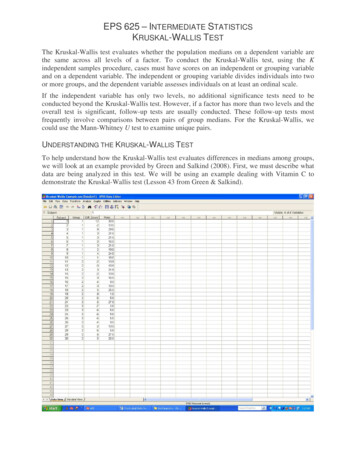
Transcription
MicrogreensMountain View Garden ClubMarch 8, 2019
What Will We Cover? What are Microgreens Why eat Microgreens Why grow Microgreens What Microgreens can I grow All About Growing Microgreens
What are Microgreens Microgreens are seedlings grown to fully expandedcotyledons or one true leaf. Microgreens are a close cousin of sprouts. Microgreens are grown with light in a soil mix unlikesprouts, which are typically grown in the darkwithout soil. Sprouts are consumed entirely-leaves, stem, & roots;only the stems & leaves of microgreens are eaten.
Immature Harvesting Growth StagesSprouts: germinated seeds with emerging rootMicrogreens: 2-3 inches in height;7-21 days (harvest stem,cotyledons, and emergingtrue leaves)Baby greens: 4-6 inchesin height; 21-40 daysMature greens: 6 inches in height; 40-60 days
Why Eat MicrogreensNutritiousVersatileVivid colorsIntense flavorTender texture
Study from University of MarylandCollege of Agriculture & Natural ns
Nutrients Assessment Objective: to analyze the concentration ofvitamins and carotenoids in 25 commerciallyavailable microgreens. Nutrients analyzed:1) Ascorbic Acid (Vc)2) Phylloquinone (VK1)3) Tocopherols (VE)4) Carotenoids (Provitamin A: β-Carotene,Lutein/zeaxanthin, Violaxanthin.)
A Major TakeawayIn comparison with nutritional concentrations in mature leaves(USDA National Nutrient Database), the microgreen cotyledon leavespossessed higher nutritional densities.
Top 5 Microgreens Rich in Carotanoids No. 1 Cilantro No. 2 Red sorrel No. 3 Garnet amaranth No. 4 Red cabbage No. 5 Pea tendril
Dietary Tips Microgreens can boost color, enhance flavor, andadd texture to any dish, while delivering a nutritionalboost as well. Some tips for adding microgreens into mealsinclude: using them as a topping for salads and soups tossing a small handful into a smoothie or juicebefore blending using them as a garnish alongside any main dish placing microgreens on top of a flatbread or pizzaafter cooking adding microgreens into an omelet or frittata replacing lettuce with microgreens on a burger,sandwich, or tacos
Why Grow Microgreens Fun & easy to grow Harvest in 10-14 days Grow year-round 1/oz. in Whole Foods
What Microgreens Can I GrowFast and easy: arugula, kale, radish, broccoli, mustard,broccoli raab, bok choy, komatsuna and other Asiangreens, cress, lettuces (fragile)
What Microgreens Can I GrowMore challenging: amaranth, beet, Swisschard, cilantro, basil, pea and sunflower shoots
Simple Steps to Growing Fill a shallow container with 1-1.5 in. ofmoist growing media Sow seeds thickly and evenly Water from bottom Harvest with scissors when 2-3 in. tall ENJOY!Seems easy enough, right?
Growing Media Soilbased – Any microgreen can be grown in soil, but thatdoesn’t mean it’s the best choice. Low growing crops like basil,for example, end up pretty messy at harvest. The closer youcan harvest your microgreens to the media while keeping itclean, the better. Soil–less media – Coco coir, blends of vermiculite and/orperlite with an organic amendment, or hydroponic lava rock areexamples of soil-less media. Hydroponic – It involves the use of a growing ‘pad’ whichabsorbs and retains water so as to keep the germinating seedsand emerging greens continually moist.
More on Media Fertilizing isn’t needed with microgreens so make suresoil based media has little or no added nutrients If using soil, it should be a germination mix whichincludes a lot of vermiculite. May need sterilization. A rule of thumb is the large seeds should be grown insoil or soil-less media. This is because they need to becovered with a small layer of soil in order for the seedcoat to shed itself from the emerging first set of leaves. Some hydroponic grow mats can be cleaned off, flippedover and used a second time – soil and soil-less mediamay not be reusable Compost leftover soil, soil-less and biodegradable mats
Commercial Flats forGrowing Large Quantities
Repurposed shallow food container(lid becomes saucer)
You Can Really Grow in Anything!
Growing Mats for Hydroponic GrowingWood fiber mats
More MatsBiostrateCoco (coir)HempSynthetic
Light First few days after planting should be a “blackout”period. Light isn’t needed, but the humidity and warmthis. Typical recommendation is to cover with a blackoutdome. Blackout times are different based on the type ofseed being planted After this period they need: Direct Sunlight – 5 hours per dayOR Indirect Sunlight – 8 hours per ns/the-ultimate-microgreen-cheat-sheet
Light (cont.) Window light may be insufficient Lettuce, arugula, mustards, Asian greens will growok in low light T-8 fluorescent lights can supplement or replacesunlight (keep tubes 2 in. from plants)
Water All water is not created equal. The ideal pH of water for microgreens is 6.0 2 teaspoons of lemon juice to gallon of water Keep media moist without being uber wet Mist or base water to keep media off plants Tray-in-tray or Container-in-container watering is apreferred method These are general recommendations as somemicrogreens prefer to be a little drier
Planting Recommended plant spacing: 3/16 in. to 1/4-in. Difficult to sow seeds evenly (no thinningnecessary) 20-row seeding flat contains around 1,000 plants
20-row seeding flat produced largerplants and root systems than plain flat
Crops in the Same Tray Should HaveSimilar Germination Rates
Tray a Variety of Crops,Containers and Locations
Invasion of the “White Fuzzies” Mold Root Hairs
Harvesting Cut at “soil line” when greens are 2-3-in. tall No re-growth Refrigerate for up to 10 days
Closer Look
What To Do With The Leftovers CompostVermicompostFlipBake (180 for 30 min)Disgard
More on Leftovers Thoroughly clean Sterilize with bleach solution
In ClosingExperiment with different seeds and containersHave fun!Enjoy your bounty!
08.03.2019 · Immature Harvesting Growth Stages. Sprouts: germinated seeds with emerging root. Microgreens: 2 -3 inches in height; 7-21 days (harvest stem, cotyledons, and emerging. true leaves) Baby greens: 4-6 inches. in height; 21-40 days. Mature greens: 6 inches in height; 40-60 days.











